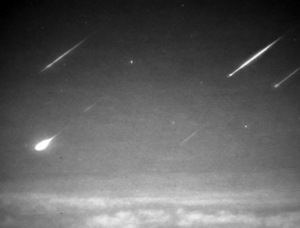The so-called 6344 P-L was first spotted in 1960, and given the designation Potentially Hazardous Asteroid - meaning that its orbit took it within .05 astronomical units (about 4,650,000 miles) of Earth's orbit. But astronomers lost track of it; left behind was only a number and a vague sense of threat.
However, meteor researcher Peter Jenniskens of the SETI institute now argues, with confirmation from the Smithsonian Astrophysical Observatory' Minor Planet Center, that this wayward wanderer is in fact the same thing as the recently discovered 2007 RR9, making a reappearance this year as part of a 4.7-year orbit.

|
| ©NASA/SETI Institute/Peter Jenniskens |
| A composite image of the Aurigid meteor shower |
"The object was long recognized to be dangerous, but we didn't know where it was. Now it is no longer just out there," said Jenniskens.
Moreover, the astronomer says, the "asteroid" doesn't really qualify as an asteroid at all. Instead, Jenniskens believes it's the dormant fragment of a comet nucleus, part of a larger body that broke up in the relatively recent past (in stellar terms), creating the Gamma Piscid meteor showers in mid-October and early November.
Under neither name is it likely to hit Earth anytime in the near future. But the little long-lost beastie will be high in the southern sky as it passes by Earth in early November, about .07 astronomical unit away (about 6.5 million miles).



Reader Comments
to our Newsletter